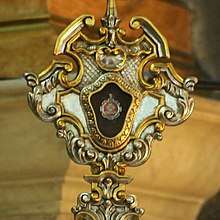Santa Marta de Pateros
Santa Marta de Pateros is a title given to a 19th-century apparition of the biblical Saint Martha of Bethany in the village of Pateros, formerly known as Aguho and was a visita of Pasig Philippines.
Santa Marta de Pateros Rosas ng Pateros | |
|---|---|
| Venerated in | Catholic Church |
| Major shrine | Diocesan Shrine of Saint Martha, Parish of Saint Roch, Pateros, Metro Manila, Philippines |
| Feast | Second Sunday of February (Pateros) July 29 (feast in the universal Church) |
| Attributes | A palm branch in the right hand, cross on left, crocodile under her feet, diadem, sash |
| Patronage | People of Pateros, duck raisers, |
Legend
Tradition recounts that in the 1800s, Saint Martha, who destroyed the Tarasque), was invoked by the people of Pateros to vanquish a giant crocodile in the Pateros River that ate their ducks. These animals were main source of their livelihood of highly priced Balut (duck eggs). In Tagalog, the Spanish loanword for duck is pato; and those who raise ducks are called pateros. At that time, domestic ducks (whose eggs produced balut) were abundant in the river that passed through Pateros.
One evening, under a full moon, a bayani (local hero) was on his way to the river to slay the creature. At the banks he saw a brilliant light surrounding the figure of Saint Martha; the creature was never seen again and the local duck industry flourished. The people of Pateros attributed this miracle to Saint Martha and a grand fluvial procession has been held in remembrance of the miracle.
Feast

Formerly, the local feast in honor of Santa Marta de Pateros was variously celebrated in either January, February, or March. The devotees selected a day within these months based on the abundance of the balut and rice harvested, and whether the date coincided with the full moon needed to illuminate the nighttime Pagoda sa Ilog (fluvial procession) as there was no electricity.
In the 1960s, the date was fixed to second Sunday of February to standardise the fiesta following economic and environmental changes to the town. It is also said that during this period, the parish priest Monsignor Sicat moved the celebration to July 29, Saint Martha’s liturgical feast in the Catholic Church.
Pamisa de Gracia
The Pamisa de Gracia (Tagalog-Spanish for “Mass of Grace”) is a ritual and Mass that opens every town fiesta. The Pamisa is done to give thanks for a miracle, birthday, or anniversary obtained or sustained through Saint Martha’s intercession. The family who will organize one borrows the icons of Saints Martha, Roch and Isidore the Labourer from the houses of their respective camareros and camareras (literally “chamberlains”, the term is used for the official caretaker of a Santo).
A sunduan (“fetching”) procession for the images begins on a Friday at the house of the caretaker of St Isidore. A brass band accompanies the image and procession, which proceeds to collect the image of St Roch from its caretaker’s house, before fetching St Martha’s icon. The day after, Saturday, has the host family conducting a prayer vigil at their house. On Sunday, the host family removes the three icons from their house, and in a second procession brings them to the Parish of Saint Roch, for the actual thanksgiving Mass. A third procession after the Mass takes the images back to the house of host family, who then return each icon to the house of its respective caretaker.
The Pamisa is also held anytime a family borrows the icons.
Shrine
In 2008, Rev. Fr. Orly Cantillon, the parish priest of the Church of San Roque in Pateros, filed a petition to Bishop Francisco C. San Diego D.D., the Bishop of Pasig, requesting that the Parish be titled the Diocesan Shrine of Saint Martha. The request was granted and the decree was presented December 2008. The proclamation was made official February 7, 2009, followed by the annual fiesta the next day.
A common error with the Filipinos that Saint Martha is the patron saint of Pateros and not Roch. This belief is supported by the fact that the Natives celebrate the event with Fiesta accompanied by merriments. While on the actual feast of Saint Roch 16 August, the moonsoon is active and often the procession cancelled. Only in the Sixties, that the Parish Priests tried to correct the problem by moving the celebration from 16 August to the nearest Sunday of the same month. Until today, the town Fiesta is simple, devoid of activities and culinary delicacies.
Sources
- Diocesan Shrine of St. Martha, Parish of St. Roch Website (Filipino)
- Diocesan Shrine of St. Martha, Parish of St. Roch Facebook page (Filipino)
- Poderes de Santa Marta de Pateros Facebook page (Filipino)
- Nocheseda, Elmer I. (March 2002). "Ecological and Ritual Change in the Devotion to Santa Marta of Pateros". Philippine Quarterly of Culture and Society. No. 1/2. University of San Carlos Publications. Volume 30: pages 65–110.